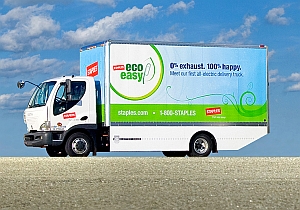A new MIT study indicates that electric vehicles have the potential to improve the bottom line for many kinds of businesses, in addition to being good for the environment. The findings from the study, conducted by researchers at MIT’s Center for Transportation and Logistics (CTL), were presented last month at the IEEE Power and Energy Society Innovative Smart Grid Technologies Conference, in Washington, D.C.
The pay-back potential for electric-powered trucks is important for companies considering adding these vehicles to their fleets, since a new electric truck today can cost nearly $150,000, compared to about $50,000 for a similar truck with an internal combustion engine. Nonetheless, electric-powered trucks when used every day to make deliveries in a big city can cost 9 to 12 percent less to operate than trucks powered by diesel engines, according to the CTL study.
For the study, the research team collected data from the office supply company Staples, which has a delivery truck fleet of 250 vehicles. The researchers also gathered data from ISO New England, the region’s electric power grid operator. With these data, the researchers developed cost models for Staples’ truck fleet using all-electric motors, conventional diesel engines, and hybrid gas-electric power. The data on all-electric trucks were not hypothetical; Staples has 53 all-electric trucks made by Smith Electric Vehicles in use in several American cities.
The models were based on assumptions of the trucks being driven 70 miles a day for 253 work days per year, with diesel gasoline costing $4.00 per gallon. (The Energy Information Administration reports as of 30 January, diesel fuel retailed nationwide for an average of $3.85 per gallon, but $4.09 in New England.) Trucks with internal-combustion engines averaged 10.14 miles per gallon, compared to 11.56 miles per gallon for hybrid trucks, while the electric-only trucks averaged 0.8 kilowatt-hours per mile.
The CTL team added one new factor to its models, namely participation in a vehicle-to-grid (V2G) system where the trucks’ batteries are plugged into the electricity grid for 12 hours overnight, as a way to provide reliable electric power to consumers. In V2G plans, currently being tested by several utility companies, truck owners would be paid by utilities for the power services they provide.
The researchers ran the models through several scenarios, altering the times that the trucks would be parked overnight. The results showed businesses could earn $900 to $1,400 per truck per year in V2G revenues in current energy markets.
These savings represent a savings of 7 to 11 percent in vehicle operating costs, in addition to the money saved on fuel and maintenance, particularly from the less wear and tear on brakes enjoyed by electric vehicles. According to the models, the operational cost per mile — the metric used by fleet managers — would drop from 75 cents per mile to 68 cents per mile when internal-combustion trucks are replaced by electric-powered trucks taking part in V2G programs.
The models, however, are based on urban truck fleets used for delivery and service, which do not need the added range for rural or interstate driving. Jarrod Goentzel, director of the Renewable Energy Delivery Project at CTL and one of study’s authors, noted that there are still plenty of trucks in this category.
“If you’re in an urban environment, almost any truck you see is a candidate,” Goentzel says. “If there’s a commercial truck in a city, it’s likely to be part of a fleet, whether it’s a service vehicle for a cable company, an electric utility truck, a mail package-delivery truck or part of a government fleet.”
Read more: Report: Electric Cars Can Balance Renewable Power Grid
* * *


 RSS - Posts
RSS - Posts
You must be logged in to post a comment.